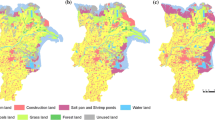Abstract
Regional land use changes are an important part of global changes. The research on land use changes in the Three Gorges Reservoir Area of China attracts a lot of attention owing to the Three Gorges Dam building. The Three Gorges Reservoir Area becomes one of the important research areas. This study analyzed the transforming processes and traits of each land use type and the regional differences of land use changes during the past 30 years, summarized the distribution of different land use types in different buffer zones and regresses the equation areas and different buffer distances based on buffer analyses and regression analyses, and then analyzed the transforming rules in different buffer distances, got the optimal influence distances. The research results indicate that, (1) cultivated land lies at the northwest of the reservoir and was decreasing, however, the construction land was increasing, especially the urban construction land, a large number of land was flooded because of the reservoir water level rise; (2) urban area was sprawling quickly in developed and neighboring areas, and a great deal of cultivated land and a considerable amount of grassland were occupied; in the earlier time, rural settlements occupied lots of cultivated land and a sum of forestry land in the later time; (3) the optimum influenced distances for cultivated land and forestry land were 10–35 km, and for urban and rural settlements were in 5–20 km. Overall, this research can reflect the spatial-temporal characteristics of land use changes during the 30 years, and it is helpful for urban planning and land use planning in the reservoir area.
Similar content being viewed by others
References
Anne M, Sylvie L, Nathalie C et al. (2006) Agriculture land use and its drivers in mountain landscape: A case study in the Pyrenees. Agriculture Ecosystems and Environment (1): 296–310.
Cao, XZ, Zuo W, Shen WM (2001) Remote sensing analysis of changes in land cover in the Three-Gorges Reservoir Region. Rural Eco-environment 17(4): 6–11. (In Chinese)
Cao YG., Wang J, Cheng Y, et al. (2006) Research of changes in cultivated land around the Reservoir Area of Three Gorges. Progress in Geography 25(6): 117–125. (In Chinese)
Damian L (2008) Land use changes in Poland during transformation Case study of Wielkopolska region. Landscape and Urban Planning (6): 279–288.
Baskent EZ, Kadiogullari AI (2007) Spatial and temporal dynamics of land use pattern in Turkey: A case study in Inegol. Landscape and Urban Planning (1): 316–327.
Fan YJ, Jiang XB (2002) Spatial-temporal variation of land use in Three-gorges’ project area based on space information technologies. Resources Science 24(5): 75–80. (In Chinese)
Guo ZJ (2004) An Analysis of the Management Mode of Towns in the Three-gorges Region. Journal of Chongqing University 27(9): 160–164. (In Chinese)
Hu L, Zhang WG, Ye XS (2006) Analyses on advantage of distribution of urbanization construction in reservoir area of three gorges. Science and Technology Management Research (10): 14–16. (In Chinese)
Porter-Bolland L, Ellis EA, Gholz HL (2007) Land use dynamics and landscape history in la Montana, Campeche, Mexico. Landscape and Urban Planning (2): 198–207.
Pontius R, Shusas E, McEachern M (2004) Detecting important categorical land changes while accounting for persistence. Agriculture Ecosystems and Environment 101(2/3): 251–268.
Wang GX, Liu JQ, Chen L (2006) Comparison of spatial diversity of land use changes and the inpacts on two typical areas of Heihe River Basin. Acta Geographica Sinica 61(4): 339–348. (In Chinese)
Wang KJ (2007) A research on the sustainable development of cities and towns in the Three Gorges Area. Urban Problems (3): 52–57. (In Chinese)
Wang ST, Zhu Y (2000). The Form Evolution and Relocation of the Cities in the Three Gorges Reservoir Area. Urban Planning Review (2): 68–74. (In Chinese)
Xiao YH, Wang L (2000) On rural urbanization of the Three-Gorges Reservoir Area along the Yangtze River. Journal of Southwest Agricultural University 22(5): 475–478. (In Chinese)
Yu TY, Si TT (2009) Per capita arable land area of the Three Gorges Reservoir Area immigrants is only 0.5 Mu. China Daily 3. (In Chinese)
Zhang XC, Xiong XS (2008) Research of spatial structure of land use change based on RS/GIS technology. Acta Scientiarum Naturalium Universitatis Sunyatseni 47(3): 117–122. (In Chinese)
Author information
Authors and Affiliations
Corresponding author
Rights and permissions
About this article
Cite this article
Cao, Y., Zhou, W., Wang, J. et al. Spatial-temporal pattern and differences of land use changes in the Three Gorges Reservoir Area of China during 1975–2005. J. Mt. Sci. 8, 551–563 (2011). https://doi.org/10.1007/s11629-011-2008-8
Received:
Accepted:
Published:
Issue Date:
DOI: https://doi.org/10.1007/s11629-011-2008-8



